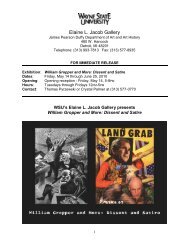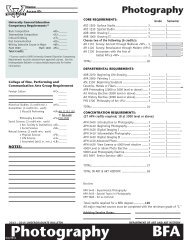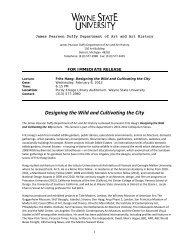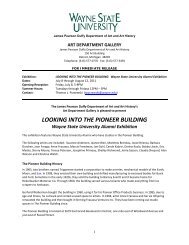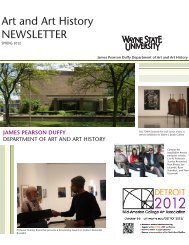linked - Department of Art and Art History - Wayne State University
linked - Department of Art and Art History - Wayne State University
linked - Department of Art and Art History - Wayne State University
Create successful ePaper yourself
Turn your PDF publications into a flip-book with our unique Google optimized e-Paper software.
Inspired by Flusser’s alternative account, this panel reconsiders the relation between the technicity<br />
<strong>and</strong> the aesthetics <strong>of</strong> photographic images. What aesthetic effects might photographs have in the<br />
“absence <strong>of</strong> a point <strong>of</strong> reference” Or, must we re-imagine what the organization by reference means<br />
Can we still think photography as medium, when every photograph is, in Flusser’s words, a<br />
”realization <strong>of</strong> one <strong>of</strong> the possibilities contained within the program <strong>of</strong> the camera” Can we reconceive<br />
photography, in its very technicity, as a power to organize emergent, differing aesthetics<br />
“The Stakes <strong>of</strong> a Medium: Photography from Document to Personal Vision”<br />
Zeynep D. Gursel, <strong>University</strong> <strong>of</strong> Michigan, Ann Arbor<br />
“<strong>Art</strong>-Work: Neo-Aesthetics “Post-Photography’”<br />
renée c. hoogl<strong>and</strong>, <strong>Wayne</strong> <strong>State</strong> <strong>University</strong><br />
“On Harold Edgerton’s “Rapatronic” Photographs <strong>and</strong> Bruce Conner’s Crossroads (1973)”<br />
Scott C. Richmond, <strong>Wayne</strong> <strong>State</strong> <strong>University</strong><br />
<strong>Art</strong> <strong>and</strong> Agriculture<br />
Friday, October 5, 9:45 AM – 11:15 AM<br />
Woodward A, Level Two, Westin Book Cadillac Hotel<br />
Chair: Lauren Kroiz, <strong>University</strong> <strong>of</strong> Wisconsin – Madison<br />
Throughout its long history – from the fifteenth-century peasant farmers featured in the Très Riches<br />
Heures du Duc de Berry to the twenty-first century Edible Estates <strong>of</strong> architect Fritz Haeg – art has<br />
looked to agriculture for inspiration. <strong>Art</strong> historians have <strong>of</strong>ten positioned the bucolic farm as a retreat<br />
or nostalgic escape from the problems or anxieties produced by the bustling city, studying the rural in<br />
subordinate relationship to the urban. Focused on the history <strong>of</strong> art in the United <strong>State</strong>s since the<br />
nineteenth century, this panel will include investigations <strong>of</strong> the political work done by the pastoral<br />
<strong>and</strong> picturesque l<strong>and</strong>scape, as well as considering exp<strong>and</strong>ed aesthetic practices to <strong>of</strong>fer new ways <strong>of</strong><br />
underst<strong>and</strong>ing the relationships between art <strong>and</strong> agriculture.<br />
“Grafting in Homer <strong>and</strong> Millet”<br />
Kenneth Haltman, <strong>University</strong> <strong>of</strong> Oklahoma<br />
“Planting Pan-Americanism: The Good Neighbor Policy <strong>and</strong> the Visual Culture <strong>of</strong> Corn,<br />
1933-1945”<br />
Breanne Robertson, Wesleyan <strong>University</strong><br />
“Buying the Farm: Collecting American Regionalist <strong>Art</strong> Then <strong>and</strong> Now”<br />
Erika Doss, <strong>University</strong> <strong>of</strong> Notre Dame<br />
“Edible Gardens: <strong>Art</strong> <strong>and</strong> Agriculture in Post-Environmental World”<br />
Terri Weissman, <strong>University</strong> <strong>of</strong> Illinois, Urbana – Champaign




